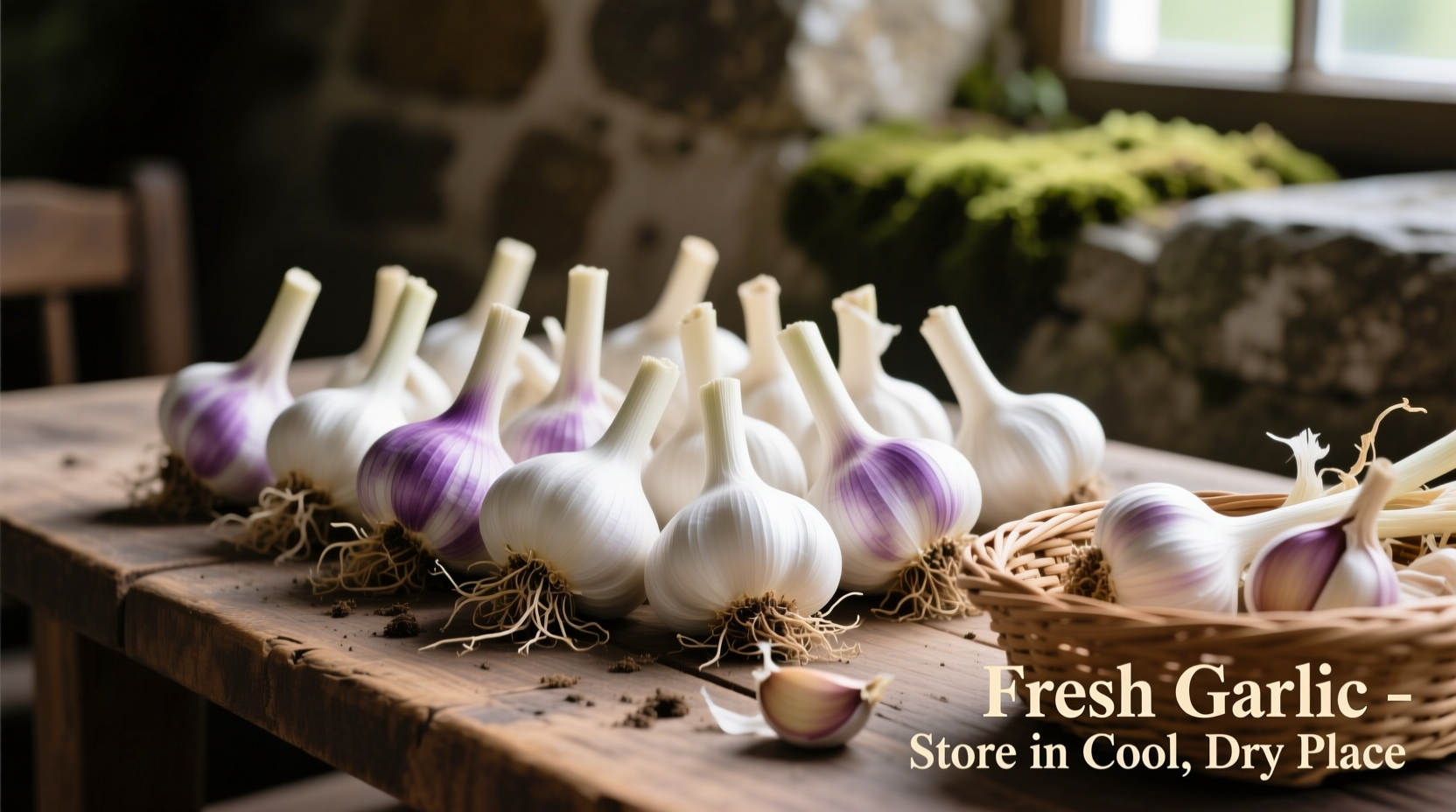Discover exactly how to preserve your garlic's flavor and potency using science-backed methods trusted by professional chefs. Whether you've harvested your own crop or bought a bulk supply, these storage techniques prevent sprouting, mold, and flavor degradation while maximizing shelf life.
The Science Behind Garlic Storage
Garlic's shelf life depends on controlling three critical factors: temperature, humidity, and airflow. According to the University of California Agriculture and Natural Resources, garlic enters dormancy after harvest but resumes metabolic activity when exposed to warmth and moisture. This triggers sprouting and enzymatic changes that degrade allicin—the compound responsible for garlic's distinctive flavor and health benefits.
| Storage Method | Temperature Range | Expected Shelf Life | Quality Preservation |
|---|---|---|---|
| Mesh bag in pantry | 60-65°F (15-18°C) | 3-6 months | ★★★★★ |
| Refrigerator (whole bulb) | 34-40°F (1-4°C) | 1-2 weeks | ★☆☆☆☆ |
| Airtight container (peeled) | 34-40°F (1-4°C) | 7-10 days | ★★★☆☆ |
| Freezer (minced) | 0°F (-18°C) | 6-12 months | ★★★☆☆ |
Step-by-Step Storage Protocol
Preparing Garlic for Storage
Before storing fresh garlic, proper preparation prevents premature spoilage. The National Center for Home Food Preservation recommends curing garlic for 2-3 weeks in a shaded, well-ventilated area. This process dries the outer layers, creating a protective barrier against moisture. Gently brush off soil without washing—water exposure initiates decay. Trim roots to ¼ inch and remove loose outer skins, but preserve the papery layers surrounding each clove.
Short-Term Storage (1-4 Weeks)
For immediate kitchen use, store unpeeled bulbs in a cool, dark pantry location using these methods:
- Mesh bags: Allow optimal airflow while protecting from light
- Wire baskets: Elevate bulbs to prevent moisture accumulation
- Braiding: Traditional method that maintains circulation between cloves
Avoid plastic bags or sealed containers—these trap humidity causing mold. Keep garlic away from onions as their emitted gases accelerate sprouting.
Medium-Term Storage (1-3 Months)
When storing larger quantities, create a controlled environment:
- Place bulbs in a ventilated container (wine crate or slotted basket)
- Add silica gel packets to absorb excess moisture
- Store in a basement or cellar maintaining 60-65°F (15-18°C)
- Check weekly for soft spots or sprouting cloves
This method preserves garlic's enzymatic integrity better than refrigeration, which causes cloves to develop rubbery textures according to USDA storage research.
Long-Term Preservation (6+ Months)
For extended storage, professional chefs use these techniques:
- Freezing minced garlic: Mix with olive oil (3:1 ratio) in ice cube trays
- Vacuum sealing: Remove air before freezing whole unpeeled bulbs
- Garlic powder: Dehydrate slices at 140°F (60°C) for 6-8 hours
Never store garlic in oil at room temperature—this creates botulism risk. Refrigerated garlic-in-oil mixtures must be used within 7 days.
Identifying Spoilage: What to Watch For
Recognize these signs indicating garlic has passed its prime:
- Texture changes: Soft spots or mushy cloves
- Color shifts: Yellow or brown streaks inside cloves
- Sprouting: Green shoots exceeding ½ inch in length
- Odor: Sour or fermented smell instead of pungent aroma
Sprouted garlic remains edible but has diminished flavor. Simply remove the green shoot before use. Discard any bulbs with black spots or slimy texture.
Avoid These Common Storage Mistakes
Even experienced cooks make these critical errors:
- Refrigerating whole bulbs: Causes premature sprouting and texture changes
- Storing in sealed jars: Creates condensation leading to mold growth
- Keeping near heat sources: Oven proximity accelerates enzymatic breakdown
- Washing before storage: Moisture initiates decay process
Garlic stored properly maintains 95% of its allicin content for 90 days, while improperly stored bulbs lose potency within 3 weeks according to Journal of Agricultural and Food Chemistry research.
Varietal-Specific Storage Guidelines
Different garlic types require tailored approaches:
- Softneck varieties (California Early, Inchelium): Store 6-8 months using standard pantry methods
- Hardneck varieties (Rocambole, Porcelain): Last 3-5 months; remove flower stalks before storage
- Solo garlic (single-clove): More perishable; use within 2 months
Hardneck garlic's central stalk creates moisture channels, making it more susceptible to mold. Store these varieties in single-layer arrangements rather than stacked containers.

Seasonal Storage Adjustments
Adapt your storage approach based on environmental conditions:
- High humidity seasons: Add extra ventilation with fan circulation
- Cold months: Move from basement to pantry if temperatures drop below 50°F (10°C)
- Warm months: Store in coolest available location away from kitchen heat
During summer months, check stored garlic twice weekly for sprouting activity. The enzymatic process accelerates at temperatures above 70°F (21°C), reducing shelf life by 30-50%.
Practical Storage Solutions for Every Kitchen
Implement these space-efficient methods regardless of kitchen size:
- Small kitchens: Use wall-mounted wire baskets near cooking area
- Large batches: Store in breathable crates on basement shelves
- Apartment living: Place mesh bags inside decorative ceramic pots
Professional chefs recommend rotating your garlic supply monthly using the "first in, first out" principle. This prevents older bulbs from getting buried and forgotten until spoiled.











 浙公网安备
33010002000092号
浙公网安备
33010002000092号 浙B2-20120091-4
浙B2-20120091-4